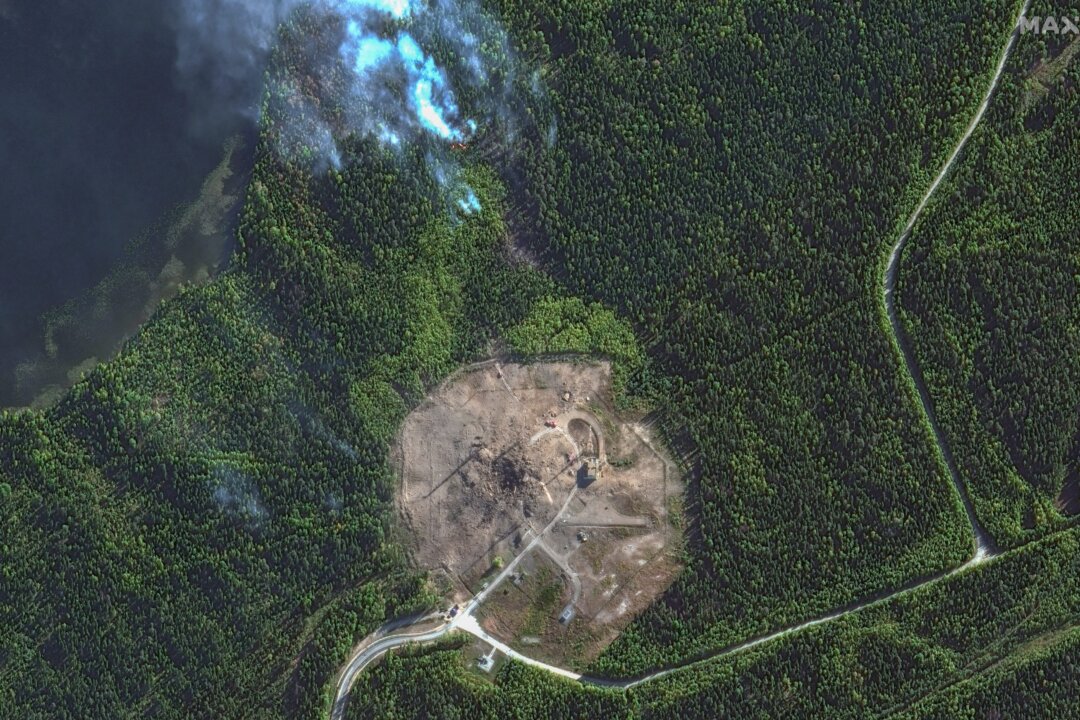A defense analyst said that President Putin would be disappointed by the Satan II missile failure, having put his ‘personal stamp’ on several nuclear programs.
Satellite images suggest that Russia has tested a Sarmat intercontinental ballistic missile and failed, according to arms experts.
The RS-28 Sarmat intercontinental ballistic missile, unofficially dubbed “Satan II” by NATO, is designed to deliver nuclear warheads to strike targets across vast distances, including the United States, Europe, and potentially other parts of the globe.
The images captured by space technology company Maxar on Sept. 21 show a crater about 60 meters (200 feet) wide at the launch silo at the Plesetsk Cosmodrome in northern Russia, revealing extensive damage that was not visible in pictures taken earlier in the month.
Arms experts who have analyzed satellite images of the launch site said the missile launch suffered a failure.
Defense commentator and analyst Tim Ripley told The Epoch Times that Russian President Vladimir Putin, who “has put his personal stamp on several of these programs,” would be disappointed by the Sarmat testing results.
“Space rockets, launchers, boosters, ballistic missiles all have their own foibles, and if something goes wrong, it goes wrong badly,” Ripley said.
“The last time Putin tried to launch one of these things, it didn’t work either.”
Ripley noted that during a 2018 annual state of the nation speech, Putin used video presentations to showcase the development of new nuclear delivery systems.
“He talked up the nuclear arms program, and he revealed several previously secret programs, and as part of his national endeavor to not be dominated by the West,” Ripley said, noting that Russia has officially rescinded from a number of nuclear arms control treaties.
For example, last year Putin officially rescinded Russia’s ratification of the treaty banning nuclear test explosions anywhere in the world.
Timothy Wright, research associate at the International Institute for Strategic Studies in London, said that analysis of the destruction of the area surrounding the missile silo could indicate a failure soon after ignition.
“One possible cause is that the first stage (booster) either failed to ignite properly or suffered from a catastrophic mechanical failure, causing the missile to fall back into or land closely adjacent to the silo and explode,” he told Reuters.On Monday, Russia said that it would not test a nuclear weapon as long as the United States refrains from doing so, after speculation that the Kremlin might start resuming so for the first time since 1990.
Last week, the head of Russia’s nuclear testing site Rear Admiral Andrei Sinitsyn told the Russian government’s official newspaper Rossiyskaya Gazeta, that the remote Novaya Zemlya archipelago in the Arctic Ocean, was ready to resume nuclear tests “at any moment” if Moscow gave the order.

Post-Soviet Russia has not carried out a nuclear test. The Soviet Union last tested in 1990, and the United States in 1992. No country except North Korea has conducted a test involving a nuclear explosion in this century.
“Nothing has changed,” Deputy Foreign Minister Sergei Ryabkov, who is in charge of Russian arms control policy, told Russian news agencies on Monday.
“As defined and formulated by the president of the Russian Federation, we can conduct such tests, but we will not conduct them if the United States refrains from such steps,” he said.
Ryabkov said preparations at Russia’s Novaya Zemlya nuclear test site to make it “fully ready” were undertaken in response to actions by the United States which he said had improved its own testing infrastructure.
Russia previously said in April 2022 that it had successfully launched a Sarmat missile and that the system is on “combat alert.”
In recent weeks, the United States and the United Kingdom have publicly signaled that they would lift restrictions on Ukraine’s use of Western precision missiles to allow Kyiv to strike targets inside Russia, though Washington has refrained from greenlighting, fearing an escalation of the conflict.
Reuters contributed to this report.

